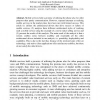Free Online Productivity Tools
i2Speak
i2Symbol
i2OCR
iTex2Img
iWeb2Print
iWeb2Shot
i2Type
iPdf2Split
iPdf2Merge
i2Bopomofo
i2Arabic
i2Style
i2Image
i2PDF
iLatex2Rtf
Sci2ools
DAIS
2006
2006
Mobile Service Oriented Architectures (MOSOA)
Mobile services hold a promise of utilizing the phone also for other purposes than purely communication. However, repeated attempts at realizing mobile services in the market place have been met with limited success. This article (1) defines the architectural drivers that drive success or failure of mobile services, (2) analyzes three different architectural styles of realizing such a mobile service using the example of a movie ticket selling service and (3) presents the results of this analysis. The main result of the analysis is that a serious conflict exists between usability and essentially all the other architectural drivers included in our analysis, i.e. portability, deployability and scalability. This is due to the fact that, because of the restricted state of the art technology, only native client applications offer satisfactory usability, but these do not satisfy the other drivers.
| Added | 30 Oct 2010 |
| Updated | 30 Oct 2010 |
| Type | Conference |
| Year | 2006 |
| Where | DAIS |
| Authors | Jilles van Gurp, Anssi Karhinen, Jan Bosch |
Comments (0)

